Exogenous Glutathione Promotes the Proliferation of Pinus koraiensis Embryonic Cells and the Synthesis of Glutathione and Ascorbic Acid
Abstract
:1. Introduction
2. Results
2.1. Effects of Exogenous GSH and BSO on EC Proliferation
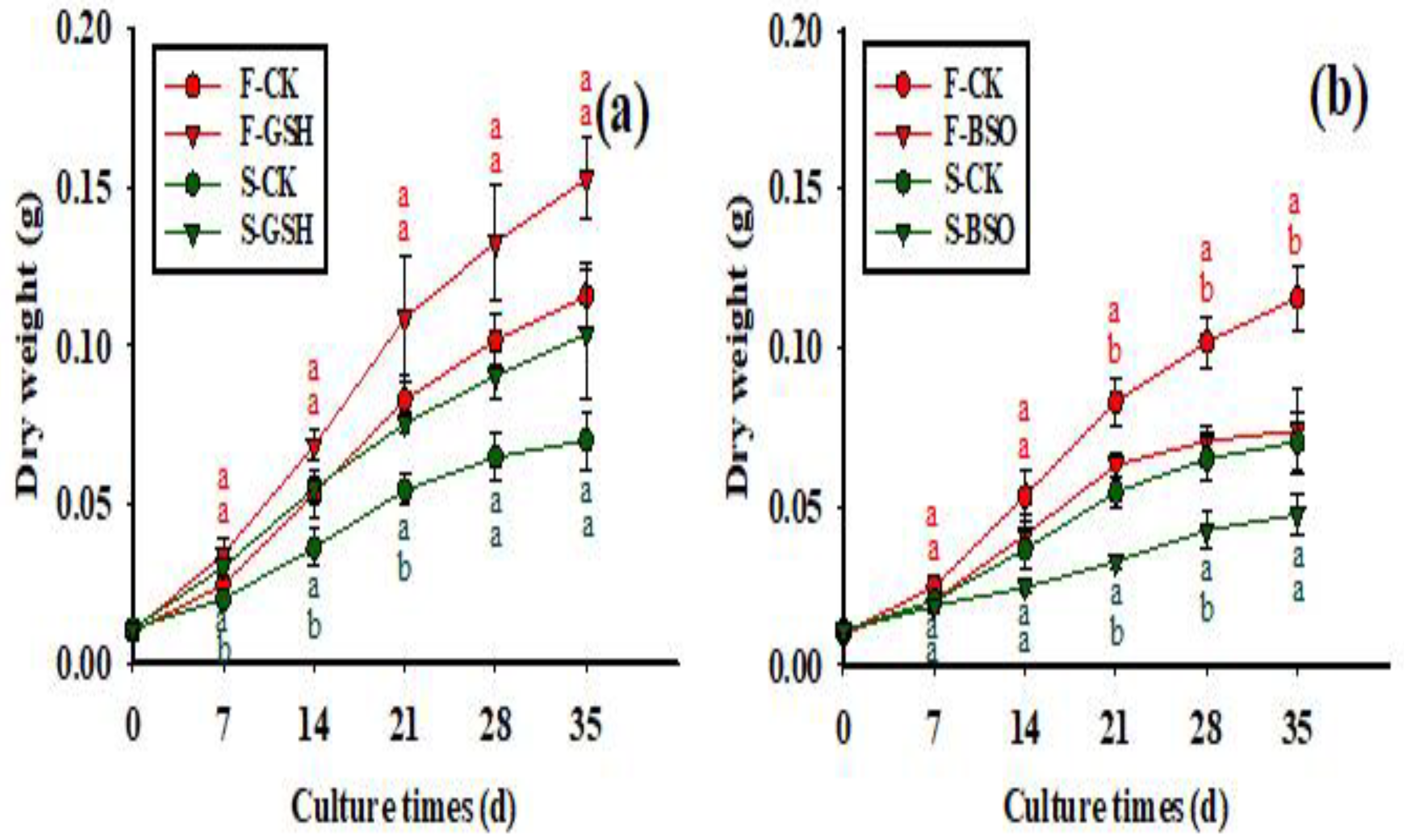
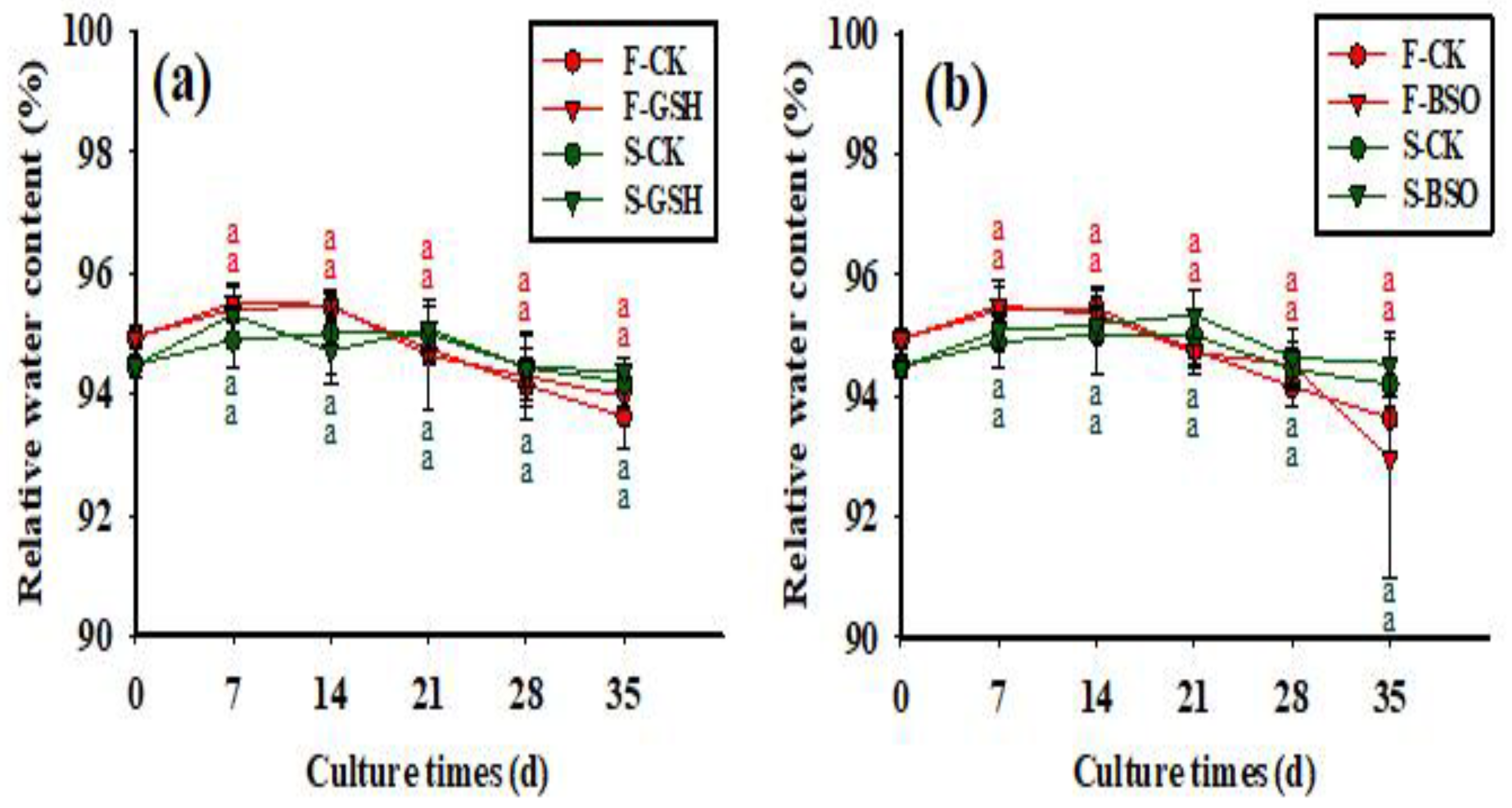
2.2. Effects of Exogenous GSH and BSO on Intracellular GSH Synthesis
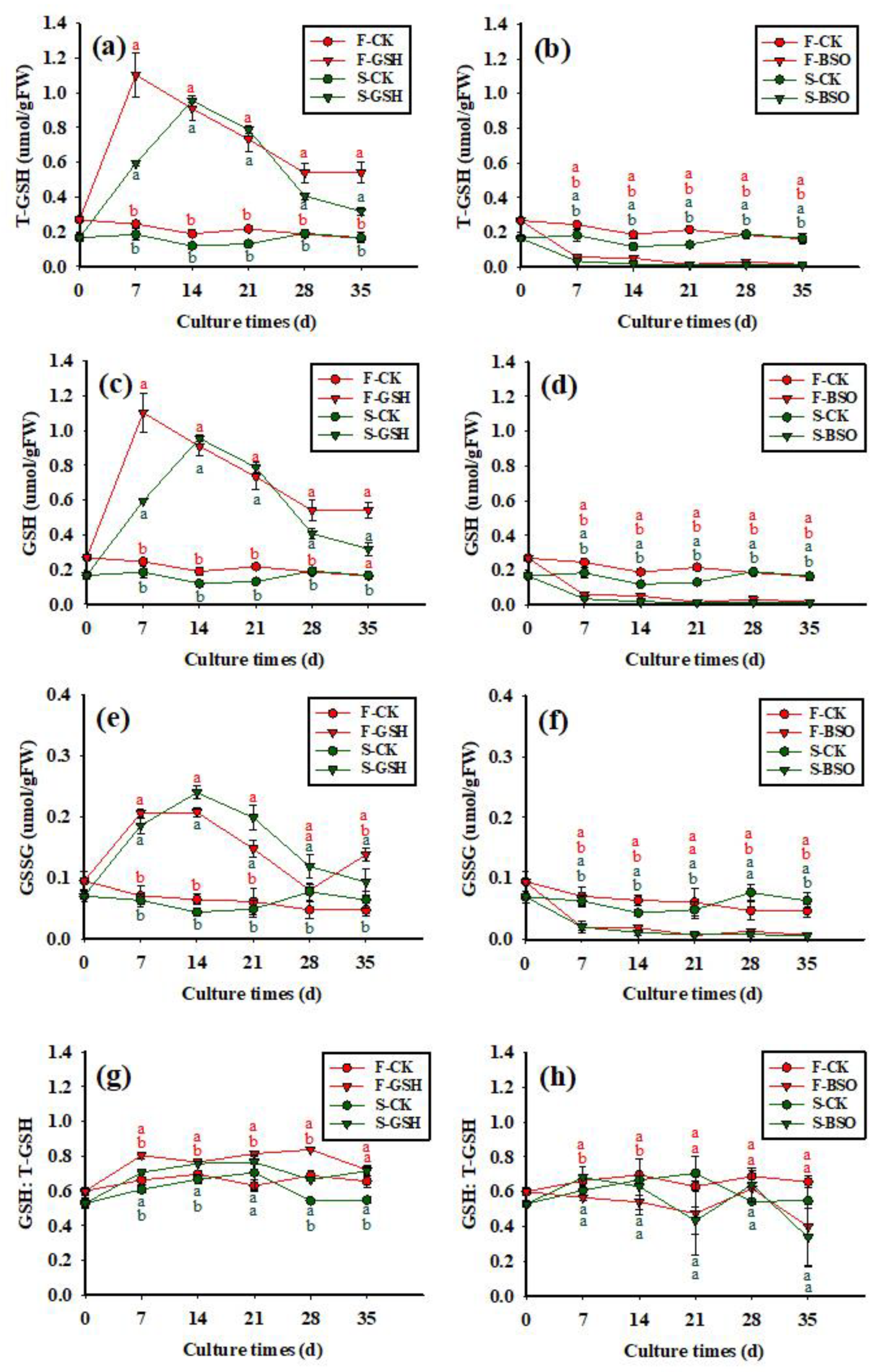
2.3. Effects of Exogenous GSH and BSO on Intracellular ASA Synthesis

2.4. Effects of Exogenous GSH and BSO on Enzymatic Activity
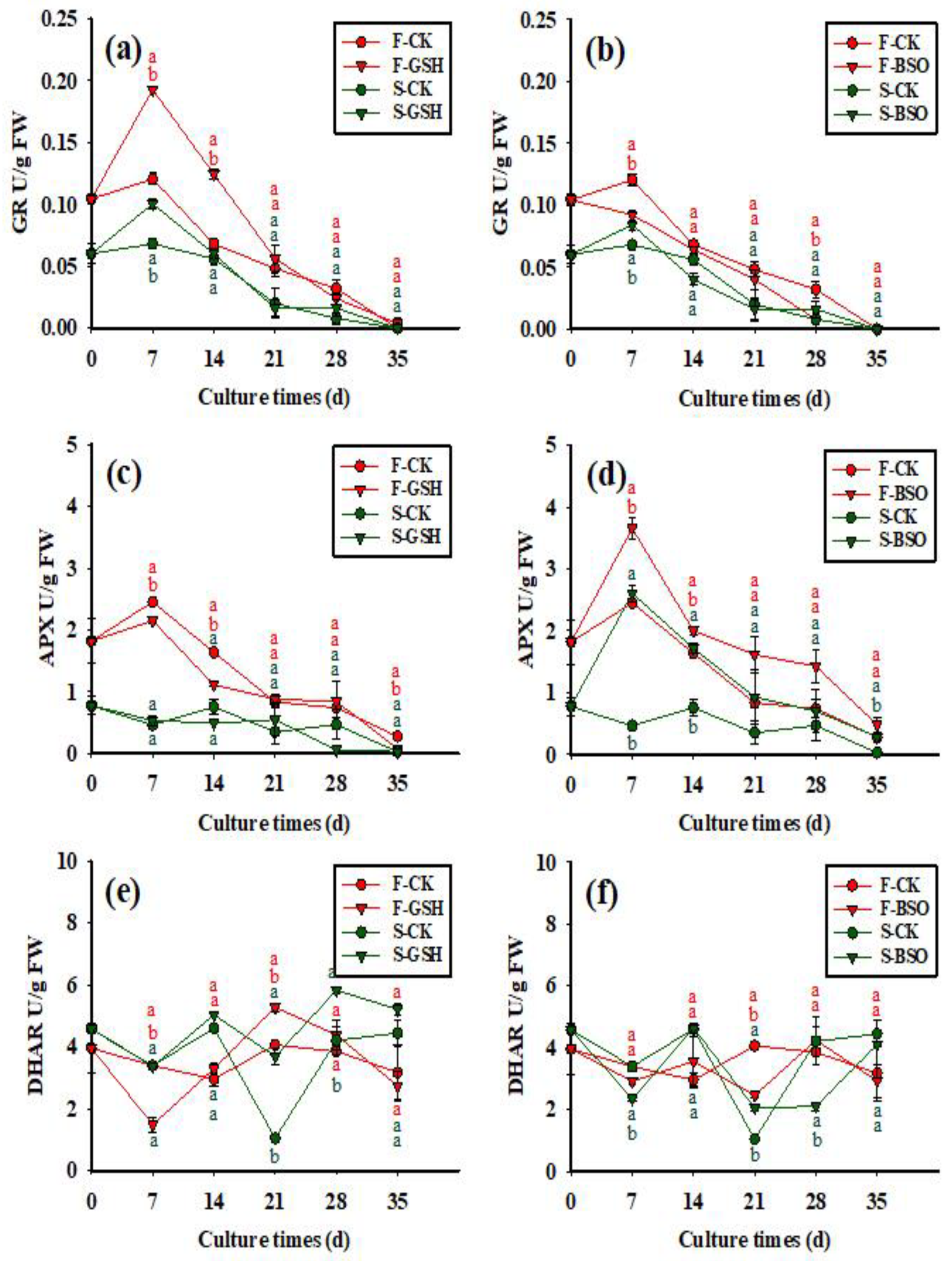
2.5. qRT-PCR Validation of Differentially Expressed Genes between GSH and BSO Treatments
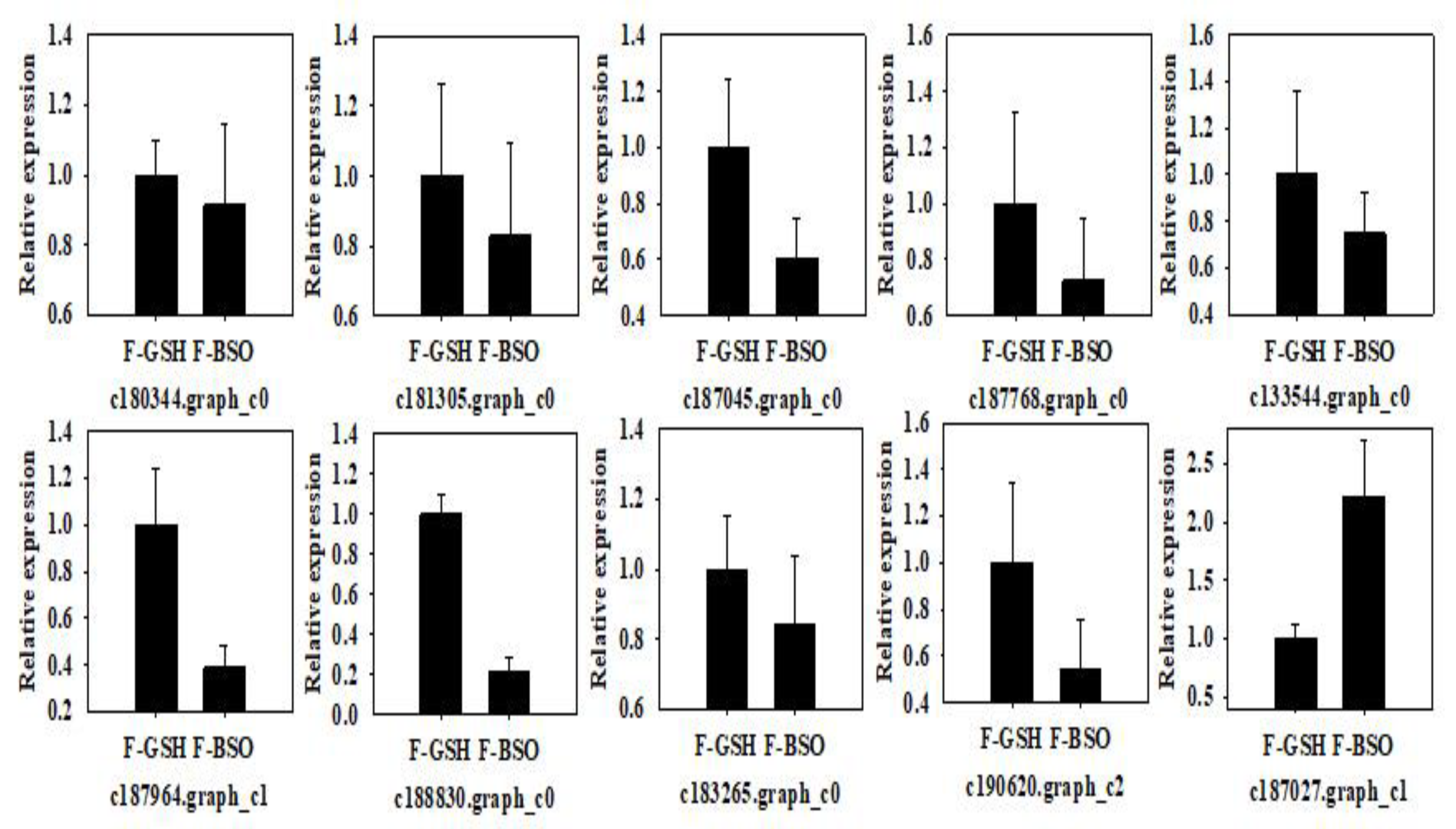
3. Discussion
4. Materials and Methods
4.1. EC Induction and Proliferation Assays
4.2. Determination of Intracellular Antioxidant Content and Enzymatic Activity
4.3. qRT-PCR Validation Assay
4.4. Calculations and Statistical Analyses
5. Conclusions
Author Contributions
Funding
Data Availability Statement
Acknowledgments
Conflicts of Interest
References
- Imin, N.; Nizamidin, M.; Daniher, D.; Nolan, K.E.; Rose, R.J. Rolfe BG Proteomic analysis of somatic embryogenesis in Medicago truncatula. Explant cultures grown under 6-benzylamino-purine and 1-naphthaleneacetic acid treatments. Plant Physiol. 2005, 137, 1250–1260. [Google Scholar] [CrossRef] [PubMed]
- Jiménez, V.M. Regulation of in vitro somatic embryogenesis with emphasis on the role of endogenous hormones. Braz. J. Plant Physiol. 2001, 13, 196–223. [Google Scholar] [CrossRef]
- von Arnold, S.I.; Sabala, I.; Bozhkov, P.; Dyachok, J.; Filonova, L. Developmental pathways of somatic embryogenesis. Plant Cell Tissue Organ Cult. 2002, 69, 233–249. [Google Scholar] [CrossRef]
- Rose, R.J.; Mantiri, F.R.; Kurdyukov, S.; Chen, S.-K.; Wang, X.-D.; Nolan, K.E.; Sheahan, M.B. Developmental biology of somatic embryogenesis. In Plant Developmental Biology-Biotechnological Perspectives; Pua, E.C., Davey, M.R., Eds.; Springer: Berlin, Germany, 2010; pp. 3–21. [Google Scholar]
- Liu, Y.; Wei, C.; Wang, H.; Ma, X.; Yang, L. Indirect somatic embryogenesis and regeneration of fraxinus mandshurica plants via callus tissue. J. For. Res. 2021, 32, 13. [Google Scholar] [CrossRef]
- Sun, T.; Wang, Y.; Zhu, L.; Liu, X.; Wang, Q.; Ye, J. Evaluation of somatic embryo production during embryogenic tissue proliferation stage using morphology, maternal genotype, proliferation rate and tissue age of pinus thunbergii parl. J. For. Res. 2022, 33, 445–454. [Google Scholar] [CrossRef]
- Peng, C.; Gao, F.; Wang, H.; Tretyakova, I.N.; Nosov, A.M.; Shen, H.; Yang, L. Morphological and Physiological Indicators for Screening Cell Lines with High Potential for Somatic Embryo Maturation at an Early Stage of Somatic Embryogenesis in Pinus Koraiensis. Plants 2022, 11, 1867. [Google Scholar] [CrossRef]
- Hazubska-Przybył, T.; Wawrzyniak, M.K.; Kijowska-Oberc, J.; Staszak, A.M.; Ratajczak, E. Somatic Embryogenesis of Norway Spruce and Scots Pine: Possibility of Application in Modern Forestry. Forests 2022, 13, 155. [Google Scholar] [CrossRef]
- Rosvall, O. Using Norway spruce clones in Swedish forestry: General overview and concepts. Scand. J. For. Res. 2019, 34, 336–341. [Google Scholar] [CrossRef]
- Belmonte, M.F.; Gillian, D.; Reid, D.M.; Yeung, E.C.; Claudio, S. Alterations of the glutathione redox state improve apical meristem structure and somatic embryo quality in white spruce (Picea glauca). J. Exp. Bot. 2005, 56, 2355–2364. [Google Scholar] [CrossRef]
- Song, Y.; Gao, X.; Wu, Y. Key Metabolite Differences Between Korean Pine (Pinus koraiensis) Seeds with Primary Physiological Dormancy and No-Dormancy. Front. Plant Sci. 2021, 12, 767108. [Google Scholar] [CrossRef]
- Peng, C.; Gao, F.; Wang, H.; Shen, H.L.; Yang, L. Physiological and biochemical traits in Korean Pine somatic embryogenesis. Forests 2020, 11, 577. [Google Scholar] [CrossRef]
- Chen, M.M.; Feng, F.; Sui, X.; Li, M.H.; Zhao, D.; Han, S. Construction of a framework map for Korean pine Sieb. et Zucc. using SRAP, SSR and ISSR markers. Trees 2010, 24, 685–693. [Google Scholar] [CrossRef]
- Geras, K.S.; Oudalova, A.; Dikareva, N.; Spiridonov, S.; Hinton, T.; Chernonog, E.; Garnier-Laplace, J. Effects of radioactive contamination on Scots pines in the remote period after the Chernobyl accident. Ecotoxicology 2011, 20, 1195–1208. [Google Scholar]
- Gao, F.; Peng, C.; Wang, H.; Tretyakova, I.N.; Nosov, A.M.; Shen, H.L.; Yang, L. Key Techniques for somatic embryogenesis and plant regeneration of Korean pine. Forests 2020, 11, 912. [Google Scholar] [CrossRef]
- Gao, F.; Peng, C.; Wang, H.; Shen, H.L.; Yang, L. Selection of culture conditions for callus induction and proliferation by somatic embryogenesis of Korean pine. J. For. Res. 2020, 32, 9. [Google Scholar]
- Peng, C.; Gao, F.; Wang, H.; Shen, H.L.; Yang, L. Optimization of maturation process for somatic embryo production and cryopreservation of embryogenic tissue in Korean pine. Plant Cell Tissue Organ Cult. 2021, 144, 185–194. [Google Scholar] [CrossRef]
- Belmonte, M.F.; Stasolla, C.; Katahira, R.; Loukanina, N.; Yeung, E.C.; Thorpe, T. Glutathione-induced growth of embryogenic tissue of white spruce correlates with changes in pyrimidine nucleotide metabolism. Plant Sci. 2005, 168, 803–812. [Google Scholar] [CrossRef]
- Belmonte, M.F.; Ambrose, S.J.; Ross, A.; Abrams, S.; Stasolla, C. Improved development of microspore-derived embryo cultures of Brassica napus cv Topaz following changes in glutathione metabolism. Physiol. Plant. 2006, 127, 690–700. [Google Scholar] [CrossRef]
- Stasolla, C. Glutathione redox regulation of in vitro embryogenesis. Plant Physiol. Biochem. 2010, 48, 319–327. [Google Scholar] [CrossRef]
- Pullman, G.S.; Zeng, X.; Copeland-Kamp, B.; Crockett, J.; Lucrezi, J.; May, S.W.; Bucalo, K. Conifer somatic embryogenesis: Improvements by supplementation of medium with oxidation-reduction agents. Tree Physiol. 2015, 35, 209–224. [Google Scholar] [CrossRef]
- Zein El Din, A.F.; Darwesh, R.S.; Ibrahim, M.F.; Salama, G.M.; Shams El-Din, I.M.; Abdelaal, W.B.; Ali, G.A.; Elsayed, M.S.; Ismail, I.A.; Dessoky, E.S.; et al. Antioxidants Application Enhances Regeneration and Conversion of Date Palm (Phoenix dactylifera L.) Somatic Embryos. Plants 2022, 11, 2023. [Google Scholar] [CrossRef] [PubMed]
- Stasolla, C.; Belmonte, M.F.; Tahir, M.; Elhiti, M.; Khamiss, K.; Joosen, R.; Maliepaard, C.; Sharpe, A.; Gjetvaj, B.; Boutilier, K. Buthionine sulfoximine (BSO)-mediated improvement in cultured embryo quality in vitro entails changes in ascorbate metabolism, meristem development and embryo maturation. Planta 2008, 228, 255–272. [Google Scholar] [CrossRef] [PubMed]
- Steiner, N.; Farias-Soares, F.L.; Schmidté, C.; Pereira, M.L.T.; Scheid, B.; Roge-Renner, G.D.; Bouzon, Z.L.; Schmidt, D.; Maldonado, S.; Guerra, M.P. Toward establishing a morphological and ultrastructural characterization of proembryogenic masses and early somatic embryos of Araucaria angustifolia (Bert.) O. Kuntze. Protoplasma 2016, 253, 487–501. [Google Scholar] [CrossRef] [PubMed]
- Rocío, S.; Fricker, M.; Corben, L.B.; White, N.S.; Sheard, N.; Leaver, C.J.; van Montagu, M.; Inzé, D.; May, M.J. Cell proliferation and hair tip growth in the Arabidopsis root are under mechanistically different forms of redox control. Proc. Natl. Acad. Sci. USA 1997, 94, 2745–2750. [Google Scholar]
- Belmonte, M.F.; Stasolla, C.; Loukanina, N.; Yeung, E.; Thorpe, T. Glutathione modulation of purine metabolism in cultured white spruce embryogenic tissue. Plant Sci. 2003, 165, 1377–1385. [Google Scholar] [CrossRef]
- Rigault, P.; Boyle, B.; Lepage, P.; Cooke JE, K.; Bousquet, J.; Mackay, J.J. A white spruce gene catalog for conifer genome analyses. Plant Physiol. 2011, 157, 14–28. [Google Scholar] [CrossRef]
- Szalai, G.; Kells, T.; Galiba, G.; Kocsy, G. Glutathione as an antioxidant and regulatory molecule in plants under abiotic stress conditions. J. Plant Growth Regul. 2009, 28, 66–80. [Google Scholar] [CrossRef]
- Bouchaud, J.P.; Potters, M. Theory of Financial Risk; Cambridge University Press: Cambridge, UK, 2000. [Google Scholar]
- Kerk, N.M.; Feldman, N.J. A biochemical model for the initiation and maintenance of the quiescent center: Implications for organization of root meristems. Development 1995, 121, 2825–2833. [Google Scholar] [CrossRef]
- Bybordi, A. Effect of ascorbic acid and silicium on photosynthesis, antioxidant enzyme activity, and fatty acid contents in canola exposure to salt stress. J. Integr. Agric. 2012, 11, 1610–1620. [Google Scholar] [CrossRef]
- Stasolla, C.; Thorpe, T.A. Purine and pyrimidine nucleotide synthesis and degradation during in vitro morphogenesis of white spruce (Picea glauca). Front. Biosci. 2004, 9, 1506–1519. [Google Scholar] [CrossRef]
- Earnshaw, B.A.; Johnson, M.A. Control of wild carrot somatic embryo development by antioxidants 1. Plant Physiol. 1987, 85, 273–276. [Google Scholar] [CrossRef] [PubMed]
- Arrigoni, O.; Gara, L.D.; Tommasi, F.; Liso, R. Changes in the ascorbate system during seed development of Vicia faba L. Plant Physiol. 1992, 99, 235–238. [Google Scholar] [CrossRef] [PubMed]
- Laura, D.G.; De, P.M.C.; Moliterni, V.M.C.; D’Egidio Maria, G. Redox regulation and storage processes during maturation in kernels of triticum durum. J. Exp. Bot 2003, 54, 249–258. [Google Scholar]
- Yeung, E.C.; Belmonte, M.F.; Tu LT, T.; Stasolla, C. Glutathione modulation of in vitro development. In Vitro Cell. Dev. Biol.-Plant 2005, 41, 584–590. [Google Scholar] [CrossRef]
- Huang, M.; Guo, Z. Responses of antioxidative system to chilling stress in two rice cultivars differing in sensitivity. Biol. Plant. 2005, 49, 81–84. [Google Scholar] [CrossRef]
- Lu, P.; Sang, W.; Ma, K. Differential Responses of the Activities of Antioxidant Enzymes to Thermal Stresses between Two Invasive Eupatorium Species in China. J. Integr. Plant Biol. 2008, 50, 393–401. [Google Scholar] [CrossRef]
- Belmonte, M.F.; Stasolla, C. Applications of DL-buthionine- [S, R]-sulfoximine deplete cellular glutathione and improve white spruce (Picea glauca) somatic embryo development. Plant Cell Rep. 2007, 26, 517–523. [Google Scholar] [CrossRef]
- Buchanan, B.B.; Gruissem, W.; Jones, R.L. Biochemistry and Molecular Biology of Plants, 2nd ed.; Wiley Blackwell: Hoboken, NJ, USA, 2015. [Google Scholar]
- Lascano, H.R.; Gómez, L.; Casano, L.M.; Trippi, V. Changes in gluthatione reductase activity and protein content in wheat leaves and chloroplasts exposed to photooxidative stress. Plant Physiol. Biochem. 1998, 36, 321–329. [Google Scholar] [CrossRef]
- Ramiro, L.H.; Gómez, L.; Casano, L.M.; Trippi, V.S. Wheat chloroplastic glutathione reductase activity is regulated by the combined effect of pH, NADPH and GSSG. Plant Cell Physiol. 1999, 40, 683–690. [Google Scholar]
- Anjum, N.A.; Chan, M.T.; Umar, S. Ascorbate-glutathione pathway and stress tolerance in plants. In Role of Ascorbate Peroxidase and Glutathione Reductase in Ascorbate-Glutathione Cycle and Stress Tolerance in Plants; Pang, C.H., Wang, B.S., Eds.; Springer: New York, NY, USA, 2010; pp. 91–113. [Google Scholar]
- Hernández, J.A.; Jiménez, A.; Mullineaux, P.; Sevilla, F. Tolerance of pea (Pisum sativum L.) to long-term salt stress is associated with induction of antioxidant defences. Plant Cell Environ. 2010, 23, 853–862. [Google Scholar] [CrossRef]
- Gueta-Dahan, Y.; Yaniv, Z.; Ben-Hayyim, Z.G. Salt and oxidative stress: Similar and specific responses and their relation to salt tolerance in Citrus. Planta 1997, 203, 460–469. [Google Scholar] [CrossRef] [PubMed]
- Lin, C.C.; Kao, C.H. Effect of NaCl stress on H2O2 metabolism in rice leaves. Plant Growth Regul. 2000, 30, 151–155. [Google Scholar] [CrossRef]
- Noshi, M.; Yamada, H.; Hatanaka, R.; Tanabe, N.; Tamoi, M.; Shigeoka, S. Arabidopsis dehydroascorbate reductase 1 and 2 modulate redox states of ascorbate-glutathione cycle in the cytosol in response to photooxidative stress. Biosci. Biotechnol. Biochem. 2017, 81, 523–533. [Google Scholar] [CrossRef]
- Litvay, J.D.; Verma, D.C.; Johnson, M.A. Influence of a loblolly pine (Pinus taeda L.). Culture medium and its components on growth and somatic embryogenesis of the wild carrot (Daucus carota L.). Plant Cell Rep. 1985, 4, 325–328. [Google Scholar] [CrossRef] [PubMed]
- Hargreaves, C.L.; Reeves, C.B.; Find, J.I.; Gough, K.; Josekutty, P.; Skudder, D.B.; Van der Maas, S.A.; Sigley, M.R.; Menzies, M.I.; Low, C.B.; et al. Improving initiation, genotype capture, and family representation in somatic embryogenesis of Pinus radiata by a combination of zygotic embryo maturity, media, and explant preparation. Can. J. For. Res. 2009, 39, 1566–1574. [Google Scholar] [CrossRef]


| Unigenes | Forward Primer | Reverse Primer |
|---|---|---|
| c154707.graph_c1 (Internal reference) | CAGCTCAGCTTGAAATGA | ACGAGTACTGTGAGGAAA |
| c180344.graph_c0 | CGACATGGTTCCAAACTA | GACCCTGAGAAAATTGTTG |
| c187964.graph_c1 | TGGAAACCCTGTTTGTGAA | GCAATGGCTCGGTCATAT |
| c188830.graph_c0 | CTCCTAGCTCTCAGGTCAT | CTTTGCGATGAGTTGTGC |
| c181305.graph_c0 | CTGGTTGGTTACACGTTCC | TGTGCATGGATAGACCGAT |
| c187768.graph_c0 | ATGGACATGAAGCATTGC | CGGTGATTGGTTACAACC |
| c183265.graph_c0 | TTCTCAATCCGAATCTGGAA | AGGAGATGTCACCGTAGTA |
| c190620.graph_c2 | GTGAAGCCGTGTCGAAGA | GGCGTTTCGTTTCACGTC |
| c187045.graph_c0 | GCAAGAGCTACAGATCAA | GGACGAAATCGTATTCAAC |
| c133544.graph_c0 | AGGGGATGAATTCAGCATA | CGCATTCACATACTTTCGA |
| c187027.graph_c1 | TGATGAAGGCTTCCACAGA | CAAGTGCTATGCGAACCC |
Publisher’s Note: MDPI stays neutral with regard to jurisdictional claims in published maps and institutional affiliations. |
© 2022 by the authors. Licensee MDPI, Basel, Switzerland. This article is an open access article distributed under the terms and conditions of the Creative Commons Attribution (CC BY) license (https://creativecommons.org/licenses/by/4.0/).
Share and Cite
Gao, F.; Shi, Y.; Wang, R.; Tretyakova, I.N.; Nosov, A.M.; Shen, H.; Yang, L. Exogenous Glutathione Promotes the Proliferation of Pinus koraiensis Embryonic Cells and the Synthesis of Glutathione and Ascorbic Acid. Plants 2022, 11, 2586. https://doi.org/10.3390/plants11192586
Gao F, Shi Y, Wang R, Tretyakova IN, Nosov AM, Shen H, Yang L. Exogenous Glutathione Promotes the Proliferation of Pinus koraiensis Embryonic Cells and the Synthesis of Glutathione and Ascorbic Acid. Plants. 2022; 11(19):2586. https://doi.org/10.3390/plants11192586
Chicago/Turabian StyleGao, Fang, Yujie Shi, Ruirui Wang, Iraida Nikolaevna Tretyakova, Alexander Mikhaylovich Nosov, Hailong Shen, and Ling Yang. 2022. "Exogenous Glutathione Promotes the Proliferation of Pinus koraiensis Embryonic Cells and the Synthesis of Glutathione and Ascorbic Acid" Plants 11, no. 19: 2586. https://doi.org/10.3390/plants11192586
APA StyleGao, F., Shi, Y., Wang, R., Tretyakova, I. N., Nosov, A. M., Shen, H., & Yang, L. (2022). Exogenous Glutathione Promotes the Proliferation of Pinus koraiensis Embryonic Cells and the Synthesis of Glutathione and Ascorbic Acid. Plants, 11(19), 2586. https://doi.org/10.3390/plants11192586








